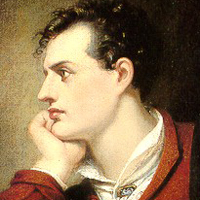Lord Byron - Biography and Works
George Gordon Noel, Sixth Baron Byron is known as Lord Byron. Byron was born in London on January 22, 1788, and educated at Harrow School and the University of Cambridge. One of the most important and versatile writers of the romantic Movement, Byron is also taken as an embodiment of the romantic spirit, in his own quixotic lifestyle; he is now mostly remembered for the contribution of his romantic hero Don Juan as a model of romantic to world literature.

Lord Byron (1788-1824)
Byron is not as popular now as the other romantic poets, but in his own lifetime he enjoyed an immense continental popularity and fame; even the nineteenth century continued to rater him as one of the greatest of the English poets and the very prototype of the literary Romanticism. His influence was seen in the way so many European artists struck ‘Byronic’ attitude: writers who imitated included the greatest- Goethe in Germany, Balzac in France, Pushkin and Dostoevsky in Russia and Melville in America – and even the greatest painters (like Delacroix), and the greatest musical composers (like Beethoven) were influenced by the Byronic spirit of freedom, rebellion and frank expression.
Though Byron is one of the Romantic poets, there are many idiosyncrasies about him, he spoke slightingly of all other romantic poets, except his friend Shelley; he hated the personal and emotional poetry of the imagination of the others. He said, “We are upon a wrong revolutionary poetic system, not worth a damn in itself” (speaking of the romantic revolution). Byron was a true disciple of the neo-classical style though in subject and theme he was a romantic. His favorite is the satire, the corrective laughter intended to delight and instruct the society, rather than express his own emotions and indulge in imaginative ideals and revolutions. He followed the aims and methods of Pope, Swift, Sterne and Voltaire. Even his short lyric poems are old fashioned in style. The main reason as to why Byron is regarded arch-Romantic poet is because of his contribution of the romantic hero. His hero is, to some extent, modeled on the life and personality of Byron himself. The type also recurs in many of his narrative poems Giaour (1813), The Bride of Abydos (1813), The Corsair (1814), and Lara (1814); but the most famous and perfect of such heroes is Don Juan himself. The Byronic hero is an image and concept that gradually developed with the different heroes that Byron created in his different works until it finally took the shape of Don Juan in his (sometimes called epic) poem the Don Juan. This romantic hero is a device through whose adventures Byron manages to expose the weakness of the society. Since there are many parallels between the picaresque hero and Byron himself, many readers see the hero as his own image, but there is a whole ‘romantic philosophy’ behind the creation of this hero (and maybe behind Byron’s personal behavior also!)
In a way, the Byronic hero is an unscrupulous seducer of women and an immoral rebel subverting all kinds of established ideals and norms of the society. But what Byron intends to do is to draw our attention towards the society whose many foibles he exposes inside out in the course of the hero’s interaction with it. His natural, frank, straightforward and above all candid behavior as contrasted to the snobbish shallow, hypocritical and inwardly immoral nature of the whole culture and society of Europe gives a striking contrasting prominence to the romantic idea of the natural man. What he does, he does out of natural impulses. He does overdo many things. But he is much better when compared to the other people who are guided by a set of hypocrisies called good manner, etiquette, decency or culture.
Cite this Page!
Sharma, K.N. "Lord Byron - Biography and Works." BachelorandMaster, 14 Nov. 2013, bachelorandmaster.com/biography/lord-byron.html.
Related Topics
Don Juan: Summary and Analysis
She Walks in Beauty: Summary and Analysis
 |
bachelorandmaster.com |